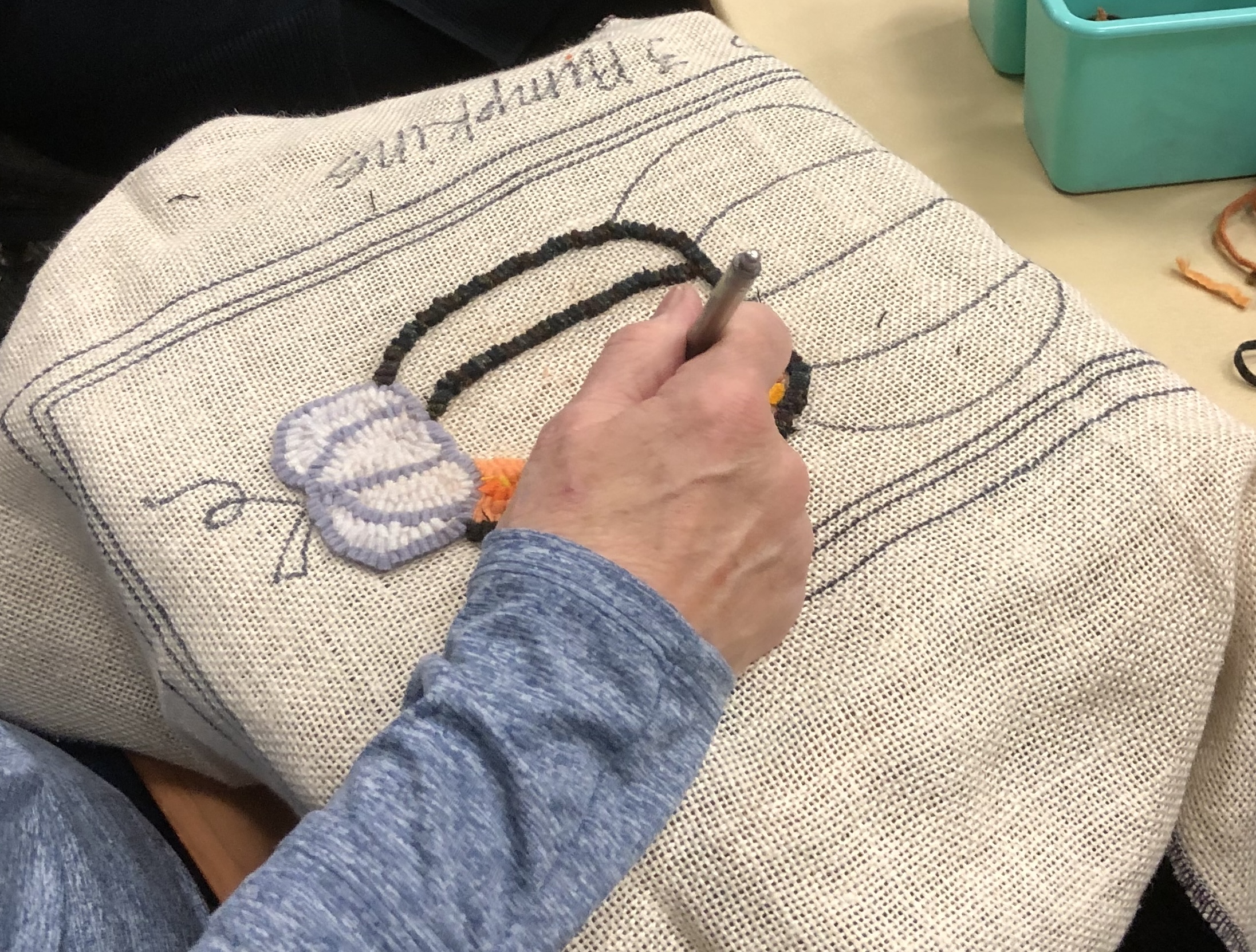There are many types of hooking. Most ATHA members are traditional or punch enthusiasts. Below are descriptions of the different rug hooking and making techniques.
Traditional Hooking – Wool fabric is cut or torn into strips that are pulled through a backing. This type of hooking is worked from the front of the piece. The earliest forms of this type of hooking used whatever scraps of fabric were around or available, and more recently, even t-shirts or other fibers and yarns are hooked into pieces.
Punch Hooking – Typically done with yarn or threads punched through a backing, usually done with an Oxford or other punch. Wool strips can also be used. In this type of hooking, the piece is worked from the back side of a backing, and the frame that is used is usually larger than the piece.
Latch Hooking – a rug making technique where short bits of yarn are tied onto a mesh-like canvas using a latch hook tool. The resulting fabric has a “shag rug” effect. Latch hooking “kits” were very popular in the United States in the 1970’s.
Locker Hooking – This rug making technique uses the same canvas backing as Latch hooking, however loops of fabric are pulled through the backing, and “locked” in place with a string or cord. Any type of fabric may be used for this technique.
Rug Tufting – this is similar to punch, however rug makers typically use an electric tufting gun to push yarn through the backing (working from the reverse side). The backs of these rugs are typically coated with glue and a secondary backing fabric is applied to secure the yarn. the front site of the rug can be trimmed to create the look of a tufted rug. This rug making technique has become popular in the early part of the 21st Century.
Why Hook?
Everyone has their reasons for choosing a craft. However, we do find there are two main categories of “hookers”.
Get-it-Done hookers – Who like to quickly do a project and move on to the next one.
Enjoy-the-Journey hookers – those who enjoy the relaxation and meditative qualities that hooking offers
Neither approach is bad or good, however there are some characteristics of hooking that might particularly appeal to people looking at a crafting experience.
Counting/Math – is not needed compared to the accuracy needed for knitting or quilting.
Working the ends in – All the “ends” of each worm are brought to the surface and simply snipped. It is not necessary to weave or sew the ends under as is needed for embroidery or cross-stitch.
Coloring – Do you like to color or draw? You can use either your own design or one already drawn on the backing.
Make a mistake? – Simply pull out the piece that has been hooked and re-hook it
Easily Repairable – Do you have a persistent cat or dog? Did something get spilled on it? Simply re-hook a damaged area of a rug, and it is good to go.
Need a crafty community? – Rug Hookers are your friends EVERYWHERE! We are always interested to hear and learn about your rug hooking journey and even your other crafty pursuits!
Equipment
Good hook, good frame, good backing, good wool will ALL make a difference in your hooking experience. However, when just getting started, it is important to work with what you have or what you can get to find out if this is a craft for you.

One thing to consider – reach out to your local rug hooking ATHA chapter or group and find out if there is a beginner class or kit that you can utilize. Joining ATHA will always help your rug hooking journey.
As you get going, you will find that over time, you will upgrade your equipment and supplies.
Beginner Equipment List
- Embroidery or quilting frame – a bit larger than the piece you intend to hook
- An inexpensive hook – even a crochet hook can get you started.
- Backing material – burlap or monk’s cloth (used in cross-stitch) can be used.
- Hooking material – preferably a stash of leftover noodles, but yarn, or any type of fabric can be cut into “noodles” usable for rug hooking.
Getting Started
Once you have your beginner pattern drawn on the backing, put it on a frame, and have your hook and noodles ready to go, what’s next?
How to hook ATHA article
Hooking lines/corners
Hooking circles
Hooking points
Resources
These are all ways to either obtain materials or learn more about rug hooking
- Consider looking at the websites of the advertisers listed on our Vendors page. These are all advertisers who support ATHA through the advertising in our magazine.
- Visit a rug hooking supplier – either their studio or brick-and-mortar storefront.
- Visit a Thrift Store to look for fabrics.
- Monitor Etsy, Ebay, craigslist, and Facebook for supplies.
- Watch YouTube channels featuring rug hooking techniques.
- Go to a museum, rug show, or demonstration attended by rug hookers.
